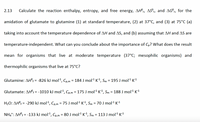
Biochemistry
9th Edition
ISBN: 9781319114671
Author: Lubert Stryer, Jeremy M. Berg, John L. Tymoczko, Gregory J. Gatto Jr.
Publisher: W. H. Freeman
expand_more
expand_more
format_list_bulleted
Question

Transcribed Image Text:2.13
Calculate the reaction enthalpy, entropy, and free energy, AH°,, ASº,, and AG°,, for the
amidation of glutamate to glutamine (1) at standard temperature, (2) at 37°C, and (3) at 75°C (a)
taking into account the temperature dependence of AH and AS, and (b) assuming that AH and AS are
temperature-independent. What can you conclude about the importance of Cp? What does the result
mean for organisms that live at moderate temperature (37°C; mesophilic organisms) and
thermophilic organisms that live at 75°C?
Glutamine: AH°; = -826 kJ mol², Cp,m = 184 J mol1 K1, Sm = 195 J mol1 K1
f%3=
Glutamate: AH°; = -1010 kJ mol1, Cp,m = 175 J mol1 K1, Sm = 188 J mol1 K1
H2O: AH°¡ = -290 kJ mol1, Cp,m = 75 J mol1 K1, Sm = 70 J mol1 K1
NH,*: AH°; = -133 kJ mol1, Cp,m = 80 J mol1 K1, Sm = 113 J mol1 K1
%3D
Expert Solution
This question has been solved!
Explore an expertly crafted, step-by-step solution for a thorough understanding of key concepts.
This is a popular solution
Trending nowThis is a popular solution!
Step by stepSolved in 5 steps with 23 images

Knowledge Booster
Similar questions
- 82.21arrow_forward54. 2,3-Bisphosphoglycerate: (MARK ALL THAT APPLY) Group of answer choices is absorbed from food binds in the central cavity in the T-form of hemoglobin. is released by the liver into the bloodstream cannot bind in the presence of oxygen preferentially binds to oxygen-bound hemoglobin and stabilizes it.arrow_forwardCalculate AG for this reaction under the following conditions: 37°C, pH 7, [Pyruvate] = [CO₂] = 4.0 mM, [OAA] = 2.0 mM, [ATP] = 3.5 mM, [P;] = 5.0 mM, and [ADP] = 1.8 mM. Use 2 signficant figures. AG= i kJ.mol-1 Under these conditions, the reaction is (Tolerance is +/- 2%)arrow_forward
- Question in photoarrow_forwardDetermine whether the following reactions will be spontaneous under standard biochemical conditions. Include calculations for Delta G in your answer. Use Table 13-7 in your textbook to help you.a) 2NADH + 2H+ + O2 --> 2NAD+ + 2H2Ob) Malate + FAD --> Oxaloacetate + FADH2c) Pyruvate + H2S --> Lactate + Sarrow_forwardIn many biochemical reactions which involves the formation of an enolate intermediate, the carbonyl oxygen of the substrate is coordinated to a divalent metal ion (usually zinc or magnesium) in the active site. Explain with structural drawings, how this ion-dipole interactions affect the acidity of the a-protons?arrow_forward
- 82.16arrow_forward3. 1,3-bisphosphglycerate has a high energy bond that can be used to phosphorylate ADP to make ATP according to the equation below. The free energy of hydrolysis of 1,3- bisphophoglycerate and ATP under standard conditions are -49.4 kJ/mol and -30.5 kJ/mol, respectively. If the [ATP] to [ADP] is about 4 in the cell, how much 1,3-bisphophoglycerate is needed relative to 3-phosphoglycerate to keep this formation of ATP spontaneous? -203PO. H- -OH -OPO3-² + ADP H- -OH -OPO3-² + ATParrow_forward1) Define metabolism and describe the importance of metabolism to life. 2) Calculate the change in free energy (∆G ) for the below reaction and answer the two follow up questions: Gfinal state = 3.4 kcal/ mol and Ginitial state = 10.7 kcal/ mol Recall: ∆G = Gfinal state – Ginitial state a. Is this a spontaneous or non-spontaneous reaction? Explain. b. Is there energy released from this reaction which can be used to do work? Explain. 2) List four conditions which impact an enzymes rate of activity. Explain.arrow_forward
arrow_back_ios
SEE MORE QUESTIONS
arrow_forward_ios
Recommended textbooks for you
 BiochemistryBiochemistryISBN:9781319114671Author:Lubert Stryer, Jeremy M. Berg, John L. Tymoczko, Gregory J. Gatto Jr.Publisher:W. H. Freeman
BiochemistryBiochemistryISBN:9781319114671Author:Lubert Stryer, Jeremy M. Berg, John L. Tymoczko, Gregory J. Gatto Jr.Publisher:W. H. Freeman Lehninger Principles of BiochemistryBiochemistryISBN:9781464126116Author:David L. Nelson, Michael M. CoxPublisher:W. H. Freeman
Lehninger Principles of BiochemistryBiochemistryISBN:9781464126116Author:David L. Nelson, Michael M. CoxPublisher:W. H. Freeman Fundamentals of Biochemistry: Life at the Molecul...BiochemistryISBN:9781118918401Author:Donald Voet, Judith G. Voet, Charlotte W. PrattPublisher:WILEY
Fundamentals of Biochemistry: Life at the Molecul...BiochemistryISBN:9781118918401Author:Donald Voet, Judith G. Voet, Charlotte W. PrattPublisher:WILEY BiochemistryBiochemistryISBN:9781305961135Author:Mary K. Campbell, Shawn O. Farrell, Owen M. McDougalPublisher:Cengage Learning
BiochemistryBiochemistryISBN:9781305961135Author:Mary K. Campbell, Shawn O. Farrell, Owen M. McDougalPublisher:Cengage Learning BiochemistryBiochemistryISBN:9781305577206Author:Reginald H. Garrett, Charles M. GrishamPublisher:Cengage Learning
BiochemistryBiochemistryISBN:9781305577206Author:Reginald H. Garrett, Charles M. GrishamPublisher:Cengage Learning Fundamentals of General, Organic, and Biological ...BiochemistryISBN:9780134015187Author:John E. McMurry, David S. Ballantine, Carl A. Hoeger, Virginia E. PetersonPublisher:PEARSON
Fundamentals of General, Organic, and Biological ...BiochemistryISBN:9780134015187Author:John E. McMurry, David S. Ballantine, Carl A. Hoeger, Virginia E. PetersonPublisher:PEARSON

Biochemistry
Biochemistry
ISBN:9781319114671
Author:Lubert Stryer, Jeremy M. Berg, John L. Tymoczko, Gregory J. Gatto Jr.
Publisher:W. H. Freeman

Lehninger Principles of Biochemistry
Biochemistry
ISBN:9781464126116
Author:David L. Nelson, Michael M. Cox
Publisher:W. H. Freeman

Fundamentals of Biochemistry: Life at the Molecul...
Biochemistry
ISBN:9781118918401
Author:Donald Voet, Judith G. Voet, Charlotte W. Pratt
Publisher:WILEY

Biochemistry
Biochemistry
ISBN:9781305961135
Author:Mary K. Campbell, Shawn O. Farrell, Owen M. McDougal
Publisher:Cengage Learning

Biochemistry
Biochemistry
ISBN:9781305577206
Author:Reginald H. Garrett, Charles M. Grisham
Publisher:Cengage Learning

Fundamentals of General, Organic, and Biological ...
Biochemistry
ISBN:9780134015187
Author:John E. McMurry, David S. Ballantine, Carl A. Hoeger, Virginia E. Peterson
Publisher:PEARSON